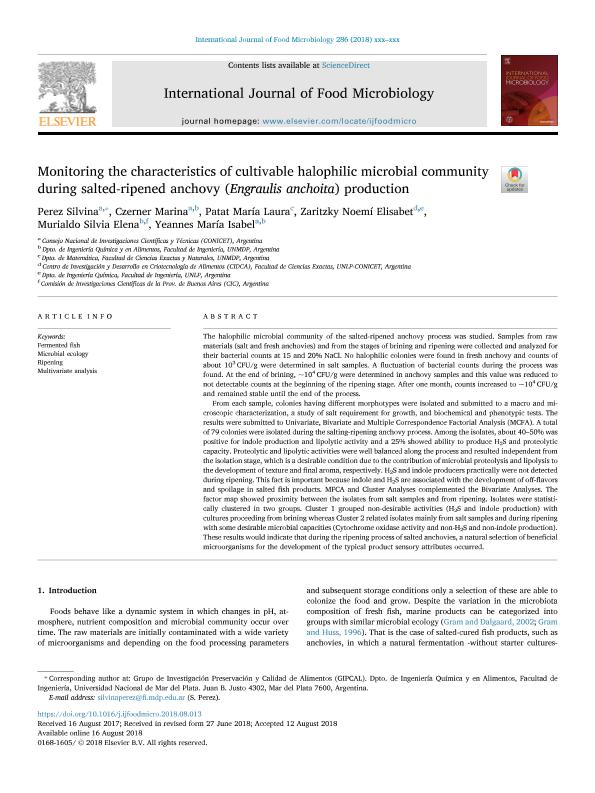Artículo
Monitoring the characteristics of cultivable halophilic microbial community during salted-ripened anchovy (Engraulis anchoita) production
Perez, Silvina; Czerner, Marina ; Patat, María Laura; Zaritzky, Noemi Elisabet
; Patat, María Laura; Zaritzky, Noemi Elisabet ; Murialdo, Silvia Elena
; Murialdo, Silvia Elena ; Yeannes, Maria Isabel
; Yeannes, Maria Isabel
 ; Patat, María Laura; Zaritzky, Noemi Elisabet
; Patat, María Laura; Zaritzky, Noemi Elisabet ; Murialdo, Silvia Elena
; Murialdo, Silvia Elena ; Yeannes, Maria Isabel
; Yeannes, Maria Isabel
Fecha de publicación:
08/2018
Editorial:
Elsevier Science
Revista:
International Journal of Food Microbiology
ISSN:
0168-1605
Idioma:
Inglés
Tipo de recurso:
Artículo publicado
Clasificación temática:
Resumen
The halophilic microbial community of the salted-ripened anchovy process was studied. Samples from raw materials (salt and fresh anchovies) and from the stages of brining and ripening were collected and analyzed for their bacterial counts at 15 and 20% NaCl. No halophilic colonies were found in fresh anchovy and counts of about 103 CFU/g were determined in salt samples. A fluctuation of bacterial counts during the process was found. At the end of brining, ~104 CFU/g were determined in anchovy samples and this value was reduced to not detectable counts at the beginning of the ripening stage. After one month, counts increased to ~104 CFU/g and remained stable until the end of the process. From each sample, colonies having different morphotypes were isolated and submitted to a macro and microscopic characterization, a study of salt requirement for growth, and biochemical and phenotypic tests. The results were submitted to Univariate, Bivariate and Multiple Correspondence Factorial Analysis (MCFA). A total of 79 colonies were isolated during the salting-ripening anchovy process. Among the isolates, about 40–50% was positive for indole production and lipolytic activity and a 25% showed ability to produce H2S and proteolytic capacity. Proteolytic and lipolytic activities were well balanced along the process and resulted independent from the isolation stage, which is a desirable condition due to the contribution of microbial proteolysis and lipolysis to the development of texture and final aroma, respectively. H2S and indole producers practically were not detected during ripening. This fact is important because indole and H2S are associated with the development of off-flavors and spoilage in salted fish products. MFCA and Cluster Analyses complemented the Bivariate Analyses. The factor map showed proximity between the isolates from salt samples and from ripening. Isolates were statistically clustered in two groups. Cluster 1 grouped non-desirable activities (H2S and indole production) with cultures proceeding from brining whereas Cluster 2 related isolates mainly from salt samples and during ripening with some desirable microbial capacities (Cytochrome oxidase activity and non-H2S and non-indole production). These results would indicate that during the ripening process of salted anchovies, a natural selection of beneficial microorganisms for the development of the typical product sensory attributes occurred.
Palabras clave:
FERMENTED FISH
,
MICROBIAL ECOLOGY
,
RIPENING
,
MULTIVARIATE ANALYSIS
Archivos asociados
Licencia
Identificadores
Colecciones
Articulos(CCT - MAR DEL PLATA)
Articulos de CTRO.CIENTIFICO TECNOL.CONICET - MAR DEL PLATA
Articulos de CTRO.CIENTIFICO TECNOL.CONICET - MAR DEL PLATA
Articulos(CIDCA)
Articulos de CENTRO DE INV EN CRIOTECNOLOGIA DE ALIMENTOS (I)
Articulos de CENTRO DE INV EN CRIOTECNOLOGIA DE ALIMENTOS (I)
Citación
Perez, Silvina; Czerner, Marina; Patat, María Laura; Zaritzky, Noemi Elisabet; Murialdo, Silvia Elena; et al.; Monitoring the characteristics of cultivable halophilic microbial community during salted-ripened anchovy (Engraulis anchoita) production; Elsevier Science; International Journal of Food Microbiology; 286; 8-2018; 179-189
Compartir
Altmétricas



